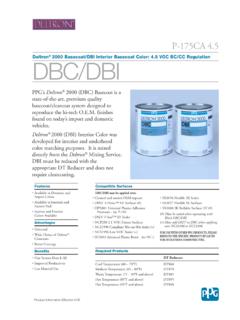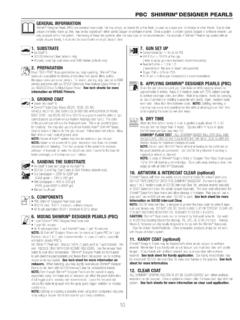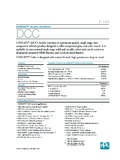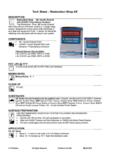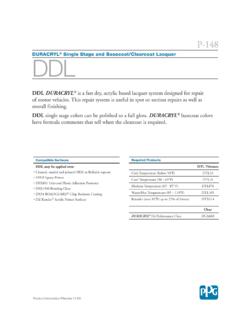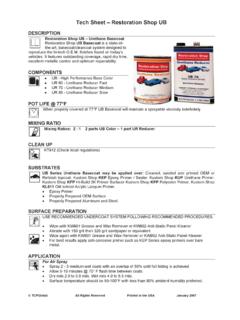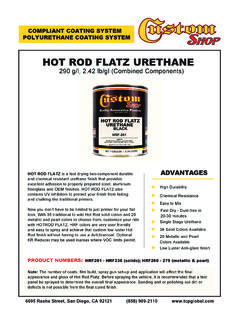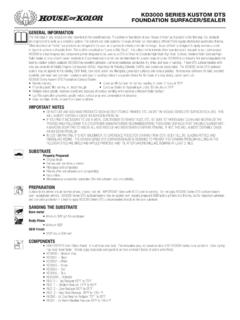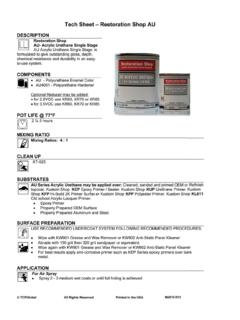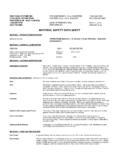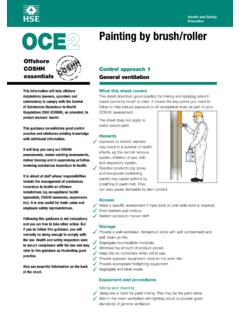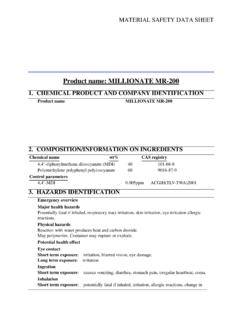Transcription of SAFETY DATA SHEET - TCP Global
1 HIGH SOLIDS HARDENERNot data SHEETP roduct nameOther means of identificationProduct typeSection 1. Identification:::Product code:DCX61 SupplierPPG Industries, PPG Place,Pittsburgh, PA 15272(412) 434-4515 ( )(514) 645-1320 (Canada)01-800-00-21-400 (Mexico)Emergency telephone number::Technical Phone Number:1-800-647-6050 Date of issue/Date of revision27 August 2015 Version5 Relevant identified uses of the substance or mixture and uses advised againstCoating. Paints. Painting-related advised againstNot use:Industrial of the substance/mixture::Section 2. Hazards identificationFLAMMABLE LIQUIDS - Category 3 ACUTE TOXICITY (inhalation) - Category 4 RESPIRATORY SENSITIZATION - Category 1 SKIN SENSITIZATION - Category 1 SPECIFIC TARGET ORGAN TOXICITY (SINGLE EXPOSURE) (Respiratory tract irritation) - Category 3 Classification of the substance or mixture:Hazard pictograms:GHS label elementsPercentage of the mixture consisting of ingredient(s) of unknown toxicity: status:This material is considered hazardous by the OSHA Hazard Communication Standard (29 CFR ).
2 United StatesPage: 1/15 HIGH SOLIDS HARDENERP roduct name5 Product codeDate of issueVersionDCX6127 August 2015 Section 2. Hazards identificationSignal word:DangerHazard statements:Flammable liquid and if cause allergy or asthma symptoms or breathing difficulties if cause an allergic skin cause respiratory statementsPrevention:Wear protective gloves. Wear eye or face protection. Wear respiratory away from heat, hot surfaces, sparks, open flames and other ignition sources. No smoking. Use explosion-proof electrical, ventilating, lighting and all material-handling equipment. Use only non-sparking tools. Take precautionary measures against static discharge.
3 Keep container tightly closed. Use only outdoors or in a well-ventilated breathing vapor. Contaminated work clothing must not be allowed out of the :IF INHALED: If breathing is difficult, remove person to fresh air and keep comfortable for breathing. Call a POISON CENTER or physician if you feel unwell. If experiencing respiratory symptoms: Call a POISON CENTER or physician. IF ON SKIN (or hair):Take off immediately all contaminated clothing. Rinse skin with water or shower. IF ON SKIN: Wash with plenty of soap and water. Wash contaminated clothing before skin irritation or rash occurs: Get medical :Store locked up.
4 Store in a well-ventilated place. Keep :Dispose of contents and container in accordance with all local, regional, national and international label elements:Moisture-sensitive material. Repeated exposure to high vapor concentrations may cause irritation of the respiratory system and permanent brain and nervous system damage. Inhalation of vapor/aerosol concentrations above the recommended exposure limits causes headaches, drowsiness and nausea and may lead to unconsciousness or death. Skin contact to isocyanate monomer may lead to allergic lung reaction. Based on the properties of the isocyanate components and considering toxicological data on similar mixtures, this mixture may cause acute irritation and/or sensitization of the respiratory system, leading to an asthmatic condition, wheezing and tightness of the chest.
5 Sensitized persons may subsequently show asthmatic symptoms when exposed to atmospheric concentrations well below the OEL. Repeated exposure may lead to permanent respiratory disability. Persons with a history of skin sensitization problems or asthma, allergies or chronic or recurrent respiratory disease should not be employed in any process in which this product is used. Avoid contact with skin and clothing. Wash thoroughly after handling. Emits toxic fumes when not otherwise classified:Prolonged or repeated contact may dry skin and cause 3. Composition/information on ingredientsSubstance/mixture:MixtureProd uct nameHIGH SOLIDS HARDENER:United StatesPage: 2/15 HIGH SOLIDS HARDENERP roduct name5 Product codeDate of issueVersionDCX6127 August 2015 Section 3.
6 Composition/information on ingredientsHexamethylene diisocyanate, oligomers 27 - <5028182-81-23-Isocyanatomethyl-3,5,5-tr imethylcyclohexyl isocyanate, oligomers 25 - <5053880-05-0heptan-2-one 10 - <17110-43-03-isocyanatomethyl-3,5,5-trim ethylcyclohexyl isocyanate - < - < nameCAS number%There are no additional ingredients present which, within the current knowledge of the supplier and in the concentrations applicable, are classified as hazardous to health or the environment and hence require reporting in this exposure limits, if available, are listed in Section concentration shown as a range is to protect confidentiality or is due to batch codes represent substances without registered CAS 4.
7 First aid measuresEye contactSkin contactInhalationIngestion::::Descriptio n of necessary first aid measuresMost important symptoms/effects, acute and delayedInhalation::IngestionSkin contact::Eye contactOver-exposure signs/symptomsInhalationAdverse symptoms may include the following:respiratory tract irritationcoughingwheezing and breathing difficultiesasthma:Eye contact:No specific acute health effectsIf ingestion, irritation, any type of overexposure or symptoms of overexposure occur during or persists after use of this product, contact a POISON CONTROL CENTER, EMERGENCY ROOM OR PHYSICIAN immediately; have SAFETY data SHEET information available.
8 Never give anything by mouth to an unconscious or convulsing contact lenses, irrigate copiously with clean, fresh water, holding the eyelids apart for at least 10 minutes and seek immediate medical to fresh air. Keep person warm and at rest. If not breathing, if breathing is irregular or if respiratory arrest occurs, provide artificial respiration or oxygen by trained contaminated clothing and shoes. Wash skin thoroughly with soap and water or use recognized skin cleanser. Do NOT use solvents or swallowed, seek medical advice immediately and show this container or label. Keep person warm and at rest. Do NOT induce known significant effects or critical if inhaled.
9 May cause respiratory irritation. May cause allergy or asthma symptoms or breathing difficulties if known significant effects or critical to the skin. May cause skin dryness and irritation. May cause an allergic skin StatesPage: 3/15 HIGH SOLIDS HARDENERP roduct name5 Product codeDate of issueVersionDCX6127 August 2015 Section 4. First aid measuresProtection of first-aiders:No action shall be taken involving any personal risk or without suitable training. If it is suspected that fumes are still present, the rescuer should wear an appropriate mask or self-contained breathing apparatus. It may be dangerous to the person providing aid to give mouth-to-mouth resuscitation.
10 Wash contaminated clothing thoroughly with water before removing it, or wear to physician:In case of inhalation of decomposition products in a fire, symptoms may be exposed person may need to be kept under medical surveillance for 48 treatments:No specific contactIngestionNo specific symptoms may include the following:irritationrednessdrynesscracki ng::See toxicological information (Section 11)Indication of immediate medical attention and special treatment needed, if necessarySection 5. Fire-fighting measuresPromptly isolate the scene by removing all persons from the vicinity of the incident if there is a fire. No action shall be taken involving any personal risk or without suitable training.
